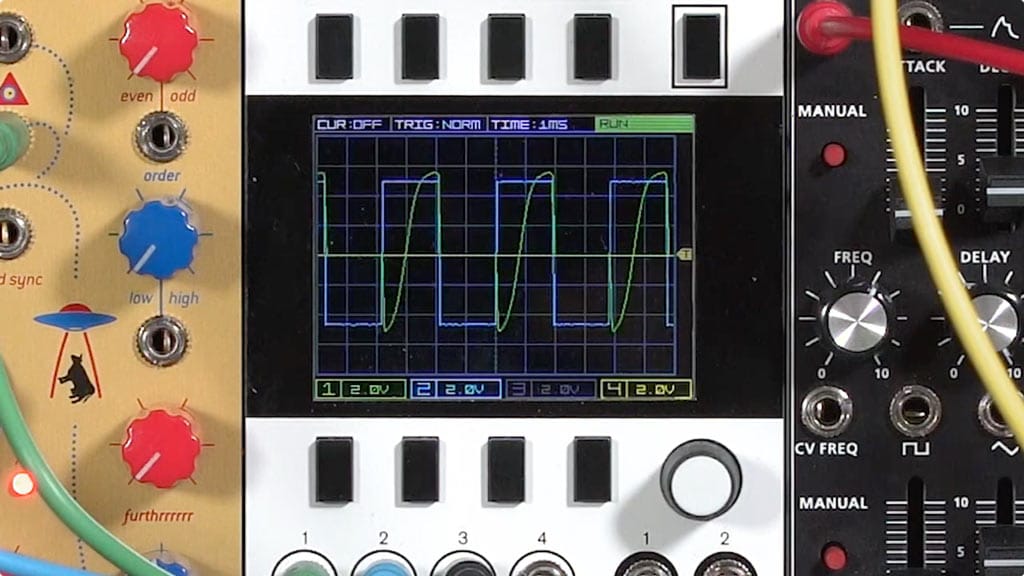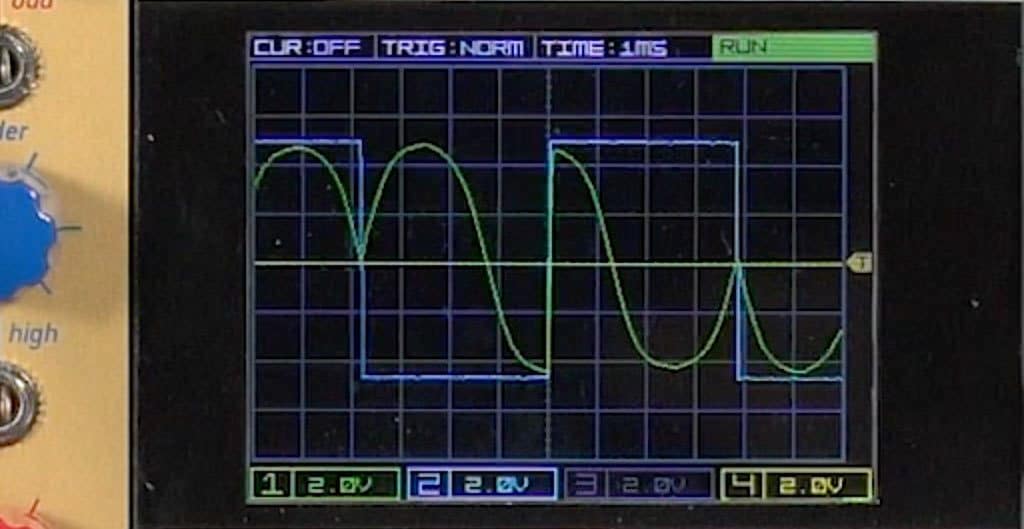Two of the older module designs around are the VCA (Voltage Controlled Amplifier) and the Ring Modulator (sometimes called a Balanced Modulator). Both use the signal from a modulator – usually a VCO – to rapidly alter the volume of a waveform from another VCO (the carrier). The result is often referred to as a “clangorous” tone as the resulting partial frequencies don’t line up with the typical integer harmonics of most instruments – something that is also true of vibrating membranes (drum heads, metal plates, etc.). Indeed, ring modulation in particular was used to synthesize bell and gong sounds before FM (frequency modulation) became popular.
So what’s the difference between the two?
Amplitude Modulation
This is your normal “plug a VCO or LFO into a VCA’s CV input” modulation. It’s know as two-quadrant modulation: While the modulation control voltage is positive, the VCA passes the carrier’s positive or negative wave segments (that’s two of the quadrants), but when the modulation signal is negative, it doesn’t pass the carrier at all, replacing it with 0v during those segments.
The result is shown in the image below: When the modulator’s square wave (the blue trace) is positive, the carrier (the green trace) is allowed through; when the modulator is negative, its shuts off the carrier from passing through the module.
The resulting harmonics are interesting. The original harmonics from the carrier are present in the output, which means some portion of the original sound is still audible. But it also creates a new set of harmonics, based on the sum and the difference of the frequencies present in both the modulator and carrier.
What do we mean by sum and difference? Imagine both the modulator and carrier were sine waves, so each brings only one harmonic to this party. If the carrier was at 500Hz and the modulator at 200Hz, the resulting sideband harmonics would be 500+200=700Hz and 500-200=300Hz. With amplitude modulation, these new harmonics get mixed together with the carrier’s original 500Hz harmonic. The lower the modulator is tuned, the closer the sidebands are to the carrier’s central harmonic; the higher they go, the more the sidebands spread apart – including to where the lower sideband goes down to 0Hz, and then reverses direction and starts rising in pitch.
Balanced Modulation
Ring or Balanced Modulation is technically known as four-quadrant modulation as it always produces sound, regardless of whether the modulator or the carrier are negative or positive. In addition to the two quadrants described above for amplitude modulation, when the modulator is negative, the positive and negative excursions of the carrier are also passed through – they’re just inverted. These are the other two quadrants. You can see this in the image below:
Those sum and difference sidebands mentioned above are still present – even more strongly, in fact. However, the carrier’s original harmonics are suppressed, meaning the result sounds very different than the original carrier wave. (Or the modulating wave, for that matter.)
The movie below compares and contrasts the two, using an Endorphin.es Furthrrrr Generator:
In short, ring modulation sounds much more “alien” than amplitude modulation, as amplitude modulation includes the original carrier and ring modulation does not. Performing a wet/dry or “depth” mix of ring modulation with the original signal produces a result similar to amplitude modulation.
How Can I Experiment With These Using My Own VCOs?
If you want patch these two different sounds yourself, the WMD MultiMode VCA supports both. If you’ve wondered what is the difference between the Mutable Instruments Blinds and Veils modules, Veils does amplitude modulation; Blinds does balanced modulation.





Thanks Chris!!!
I did this “lesson” with my verbox Complex Osc…thks again!
Hi Chris, I’ve seen references to the term “2 operator FM”. Is this a synonym for two quadrant modulation that you cover in the article?
If not, could you explain the differences? Many thanks!
“2 operaator FM” is Frequency Modulation, rather than a form of amplitude modulation. A simple FM pair – a modulator and a carrier oscillator – are the two “operators”.
This post & video goes through three different variations of 2-operator FM: https://learningmodular.com/understanding-the-differences-between-exponential-linear-and-through-zero-fm/
Hey Chris. Great demo.
I’m wondering if you have any content that demonstrates the use of a 4QM at a sub-audio rate? The carrier & modulator being LFO’s instead of VCO’s.
Thanks
I did, over on my Patreon channel – I wrote a long post demonstrating different ways to process simple triangle LFOs into more interesting waveshapes using mixing, filtering, saturation, wave folding, ring modulation (four quadrant multipliers), and feedback (for voltage-controlled LFOs): https://www.patreon.com/posts/39742822